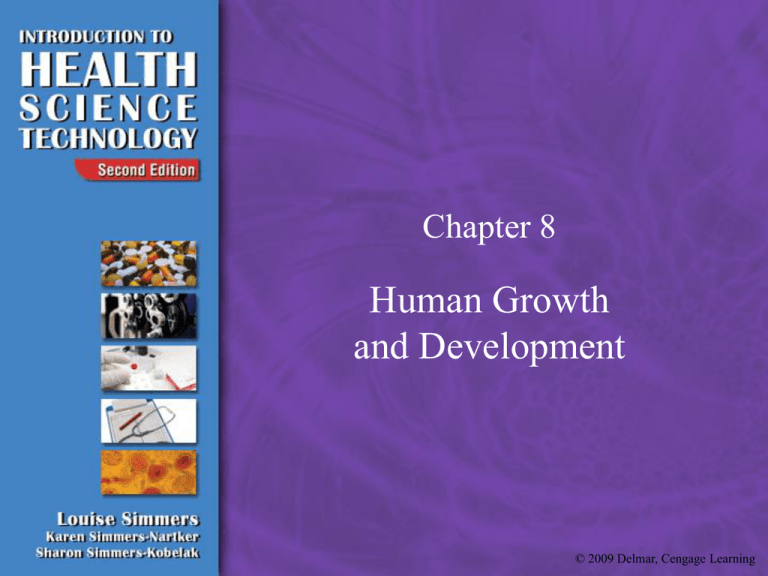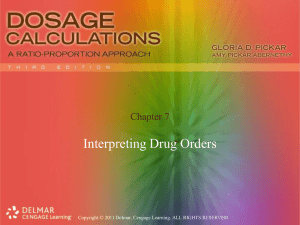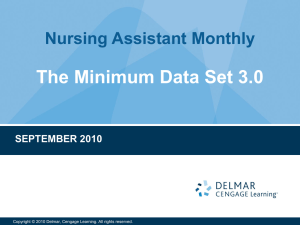Chapter 8
advertisement

Chapter 8 Human Growth and Development © 2009 Delmar, Cengage Learning 8:1 Life Stages • Growth spans an individual’s lifetime • Development is the process of becoming fully grown • Health care workers need to be aware of the various stages and needs of the individual to provide quality health care (continues) © 2009 Delmar, Cengage Learning Life Stages (continued) • • • • • • • Infancy: birth to 1 year Early childhood: 1–6 years Late childhood: 6–12 years Adolescence: 12–20 years Early adulthood: 20–40 years Middle adulthood: 40–65 years Late adulthood: 65 years and older © 2009 Delmar, Cengage Learning Growth and Development Types • • • • Physical: body growth Mental: mind development Emotional: feelings Social: interactions and relationships with others • Four types above occur in each stage © 2009 Delmar, Cengage Learning Erikson’s Stages of Psychosocial Development • Erik Erikson was a psychoanalyst • A basic conflict or need must be met in each stage • See Table 8-1 in text © 2009 Delmar, Cengage Learning Infancy • • • • • • • Age: birth to 1 year old Dramatic and rapid changes Physical development Mental development Emotional development Social development Infants are dependent on others for all of their needs © 2009 Delmar, Cengage Learning Early Childhood • • • • • • Age: 1–6 years old Physical development Mental development Emotional development Social development The needs of early childhood include routine, order, and consistency © 2009 Delmar, Cengage Learning Late Childhood or Preadolescence • • • • • • Age: 6–12 years old Physical development Mental development Emotional development Social development Children in this age group need parental approval, reassurance, peer acceptance © 2009 Delmar, Cengage Learning Adolescence • • • • • • Age: 12–20 years old Physical development Mental development Emotional development Social development Adolescents need reassurance, support, and understanding © 2009 Delmar, Cengage Learning Eating Disorders • Often develop from an excessive concern for appearance • Anorexia nervosa • Bulimia • More common in females • Usually, psychological or psychiatric intervention is needed to treat either of these conditions © 2009 Delmar, Cengage Learning Chemical Abuse • Use of alcohol or drugs with the development of a physical and/or mental dependence on the chemical • Can occur at any life stage, but frequently begins in adolescence • Can lead to physical and mental disorders and diseases • Treatment towards total rehabilitation © 2009 Delmar, Cengage Learning Reasons Chemicals Used • Trying to relieve stress or anxiety • Peer pressure • Escape from either emotional or psychological problems • Experimentation • Seeking “instant gratification” • Hereditary traits or cultural influences © 2009 Delmar, Cengage Learning Suicide • One of the leading causes of death in adolescents • Permanent solution to temporary problem • Impulsive nature of adolescents • Most give warning signs • Call for attention • Prevention of suicide © 2009 Delmar, Cengage Learning Reasons for Suicide • • • • • • Depression Grief over a loss or love affair Failure in school Inability to meet expectations Influence of suicidal friends or parents Lack of self-esteem © 2009 Delmar, Cengage Learning Increased Risk of Suicide • • • • Family history of suicide A major loss or disappointment Previous suicide attempts Recent suicide of friends, family, or role models (heroes or idols) © 2009 Delmar, Cengage Learning Early Adulthood • • • • • Age: 20–40 years old Physical development Mental development Emotional development Social development © 2009 Delmar, Cengage Learning Middle Adulthood (Middle Age) • • • • • Age: 40–65 years of age Physical development Mental development Emotional development Social development © 2009 Delmar, Cengage Learning Late Adulthood • • • • • • Age: 65 years of age and older Physical development Mental development Emotional development Social development The elderly need a sense of belonging, self-esteem, financial security, social acceptance, and love © 2009 Delmar, Cengage Learning 8:2 Death and Dying • Death is “the final stage of growth” • Experienced by everyone and no one escapes • Young people tend to ignore it and pretend it doesn’t exist • Usually it is the elderly, who have lost others, who begin to think about their own death © 2009 Delmar, Cengage Learning Terminal Illness • Disease that cannot be cured and will result in death • People react in different ways • Some patients fear the unknown while others view death as a final peace © 2009 Delmar, Cengage Learning Research • Dr. Elizabeth Kübler-Ross was the leading expert in the field of death and dying and because of her research – Most medical personnel now believe patients should be informed of approaching death – Patients should be left with some hope and know they will not be left alone – Staff need to know extent of information known by patients (continues) © 2009 Delmar, Cengage Learning Research (continued) • Dr. Kübler-Ross identified five stages of grieving • Dying patients and their families and friends may experience these stages – Stages may not occur in order – Some patients may not progress through them all, others may experience several stages at once © 2009 Delmar, Cengage Learning Stages of Death and Dying • Denial—refuses to believe • Anger—when no longer able to deny • Bargaining—accepts death, but wants more time • Depression—realizes death will come soon • Acceptance—understands and accepts the fact they are going to die © 2009 Delmar, Cengage Learning Caring for the Dying Patient • • • • Very challenging, but rewarding work Supportive care Health care worker must have self-awareness Common to want to avoid feelings by avoiding dying patient © 2009 Delmar, Cengage Learning Hospice Care • Palliative care only • Often in patient’s home • Philosophy: allow patient to die with dignity and comfort • Personal care • Volunteers • After death contact and services © 2009 Delmar, Cengage Learning Right to Die • Ethical issues must be addressed by the health care worker • Laws allowing “right to die” • Under these laws specific actions to end life cannot be taken • Hospice encourages LIVE promise • Dying Person’s Bill of Rights © 2009 Delmar, Cengage Learning Summary • Death is a part of life • Health care workers must understand death and dying process and think about needs of dying patients • Then health care workers will be able to provide the special care these individuals need © 2009 Delmar, Cengage Learning 8:3 Human Needs • Needs: lack of something that is required or desired • Needs exist from birth to death • Needs influence our behavior • Needs have a priority status • Maslow’s hierarchy of needs (See Figure 8-15 in text) © 2009 Delmar, Cengage Learning Altered Physiological Needs • Health care workers need to be aware of how illness interferes with meeting physiological needs • Surgery or laboratory testing • Anxiety • Medications • Loss of vision or hearing (continues) © 2009 Delmar, Cengage Learning Altered Physiological Needs (continued) • • • • Decreased sense of smell and taste Deterioration of muscles and joints Change in person’s behavior What the health care worker can do to assist the patient with altered needs © 2009 Delmar, Cengage Learning Meeting Needs • • • • Motivation to act when needs felt Sense of satisfaction when needs met Sense of frustration when needs not met Must prioritize when several needs are felt at the same time • Different needs can have different levels of intensity © 2009 Delmar, Cengage Learning Methods for Satisfying Needs • Direct methods – – – – Hard work Set realistic goals Evaluate situation Cooperate with others (continues) © 2009 Delmar, Cengage Learning Methods for Satisfying Needs (continued) • Indirect methods – – – – – – Defense mechanisms Rationalization Projection Displacement Compensation Daydreaming © 2009 Delmar, Cengage Learning Methods for Satisfying Needs (continued) • Indirect methods (continued) – – – – Repression Suppression Denial Withdrawal © 2009 Delmar, Cengage Learning Summary • Be aware of own needs and patient’s needs • More efficient quality care can be provided when needs are recognized • Better understanding of our behavior and that of others © 2009 Delmar, Cengage Learning





